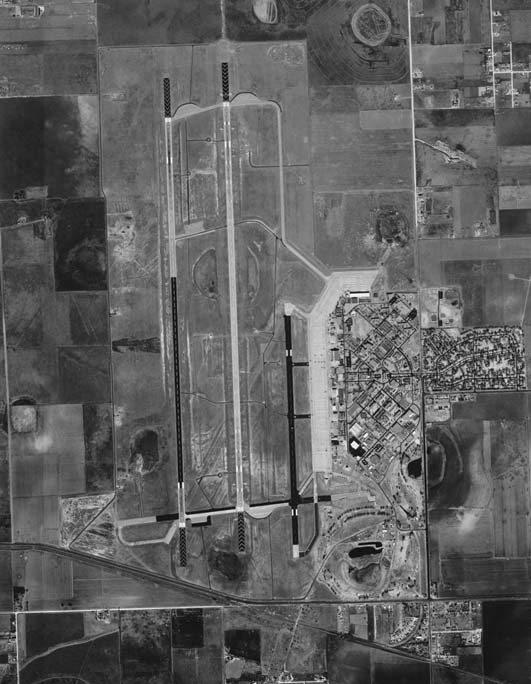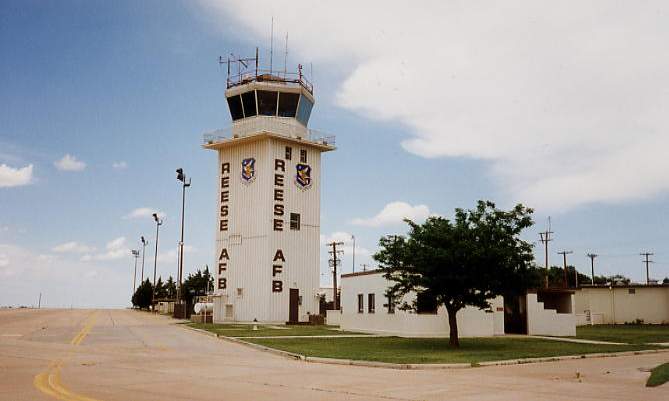

REESE AIR FORCE BASE
|
Hearing the Winds of War in 1941, the City of Lubbock offered 2,000 acres to the War Department to build and airfield. Cotton fields & grassland gave way to a huge military installation when construction began on August 22, 1941 and 5 months later, Lubbock Field officially opened on January 22, 1942.
It was originally known as the Lubbock Army Air Corps Advanced Flying School and offered primary flight training to cadets & instrument training for pilots.
The base was renamed to the Lubbock Army Flying School in early 1943, and then to Lubbock Army Airfield later that year. Aircraft flown from the base during WW2 included the T-6 Texan, AT-17 Bobcat, and AT-9 Jeep.
The base was closed at the end of 1945, after graduating 7,009 pilots. In the post-WW2 years, the base was reportedly used as a meeting place for National Guard, Air Reserve, and Naval Reserve units.
Lubbock was reactivated by the Air Force in 1949 as a multiengine pilot-training base. It was named Lubbock Air Force Base, until being renamed Reese Air Force Base in late 1949. Reese Air Force Base is named in honor of 1st Lt Augustus F. Reese, Jr., of Shallowater, Texas, who lived about ten miles north of the base. He was killed in action at Cagliari, Sardinia, May 14, 1943, while flying a P-38 on a voluntary mission to destroy a railroad supply train. Lieutenant Reese was honored when his name was selected for the base at the suggestion of a committee of Lubbock residents. The main aircraft used at Reese during this period was the TB-25 Mitchell bomber, which was used to train student officers & aviation cadets.
The AT-6 Texan was also used starting in 1949 to augment multi-engine pilot training. The last AT-6 training mission took place at Lubbock on May 19, 1953. The TB-25 was used at Reese until the base was converted to single-engine jet training in 1959. The last TB-25 to fly at Reese was placed on static display at the main entrance to the base.
The T-33, a single-engine jet, was the only training aircraft at Reese from January 1959 until the T-37 arrived in March 1961. Undergraduate Pilot Training Class 63-D arrived in November, 1961. |

Circa 1996

Taken just before the Base closed in 1997
|
The supersonic T-38 was used at Reese starting in 1963 to permit qualification of pilots for quicker transition to larger & faster aircraft. From March 1965 to June 1973, a military version of the Cessna 172, the T-41, was used at Reese. Reese began using the first Operational Instrument Flight Simulator in August 1977.
The base became a focal point for national media in 1979 when the Crown Prince of Iran began his military flight training at Reese. His residence in the South Plains was cut short several months later, however, with the deposition of his father, The Shah Of Iran. The Crown Prince, as a security measure, was returned to his homeland under cover of night.
Reese AFB was also home to the very first female USAF pilot trainees in the late 1970s.
The T-1A Jayhawk, the first new training aircraft to be added to the U.S. Air Force inventory in 30 years, arrived at Reese on 18 January 1992. During its last decade (the 1990s), Reese conducted Specialized Undergraduate Pilot Training, using a complement of 200 aircraft (the T-37, T-38, and T-1).
In 1995 the Base Realignment and Closure Commission designated Reese for closure, to be carried out in 2 years. Reese was closed in 1997.
In its history, Reese had trained a total of 25,349 pilots. At the time of its closure, the base consisted of a total of 3,000 acres, with some 700 buildings. The airfield consists of 3 North/South runways (the largest is 10,500' long), along with large ramp areas & numerous large hangars. The remains of 2 other crosswind runways also still exist.
The local government is redeveloping Reese for civilian businesses, as the Reese Technology Center. It now has a variety of tenants, including the Texas Tech University, a police training center, and South Plains College.
As of 2004, the airfield is listed as Reese Airpark, a private airfield owned by the Lubbock Reese Development Authority.
Thanks to Paul Freeman for much of the above info. Visit his site at Abandoned & Little-Known Airfields |